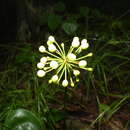pt-BR
nomes no trilho de navegação


Clintonia umbellulata, commonly known as white clintonia or speckled wood-lily,[3][4] is a species of flowering plant in the lily family Liliaceae. The specific epithet umbellulata means "umbelled," which refers to the shape of the plant’s inflorescence.

Clintonia umbellulata is a perennial herbaceous plant that spreads by means of underground rhizomes. A plant stands 27 to 60 cm (11 to 24 in) tall with 2–4 dark green leaves, each 18 to 30 cm (7 to 12 in) long and 4.5 to 8 cm (2 to 3 in) wide. The inflorescence is a single terminal umbel with 10–25(–30) outward-facing flowers on a flowering stalk up to 50 cm (20 in) high. Each flower has six tepals and six stamens. The tepals are white or greenish white, often marked with purplish brown or green speckles, each tepal being 5.5 to 8 mm (0.2 to 0.3 in) long and 2.7 to 4 mm (0.1 to 0.2 in) wide. The stamens are 60% longer than the tepals. The fruits are black (occasionally ultramarine blue) berries, each 6 to 8 mm (0.2 to 0.3 in) long with 2–4 seeds per berry. Each seed is approximately 3.5 mm (0.1 in) long.[4][5][6]
Because of their proximity, Clintonia umbellulata and C. borealis are often confused. The following table compares the two species character by character (with diagnostic characters emphasized):[4][7]
Based on morphological characters alone, bare-leaved plants may be difficult to identify. In this case, Clintonia umbellulata is distinguished from C. borealis by the presence of hairs longer than 1 millimeter on the underside midvein.
C. umbellulata has numerous look-alikes. For example, the inflorescence of the small white leek (Allium tricoccum) is very similar in appearance. To distinguish the two, look at the leaves. The leaves of A. tricoccum have usually wilted by the time the plant is in full bloom while the leaves of C. umbellulata remain throughout the summer months.
In 1803, André Michaux described the species Convallaria umbellulata Michx.,[8] a name that was to become a synonym for Clintonia umbellulata (Michx.) Morong. The latter was first described by Thomas Morong in 1894.[9]
In 1933, John Kunkel Small described the segregate species Xeniatrum umbellulatum,[5] a distinction that did not persist. Numerous other synonyms are in use. Perhaps the best known is Clintonia alleghaniensis Harned,[10] which unlike C. umbellulata has ultramarine blue (not black) fruit. It is known to occur at a number of sites in Virginia, Maryland, and West Virginia.[11]
Clintonia umbellulata is endemic to the Appalachian Mountains in the eastern United States, from New York to Georgia.[2][12] Counties where the species is known to occur are listed below:
The range of C. umbellulata apparently overlaps with that of C. borealis throughout the Appalachian Mountains.[12][13] (Counties where both species are known to occur are shown above in bold.) Actually C. umbellulata and C. borealis are allopatric,[4] that is, the ranges of the two species do not significantly overlap but are immediately adjacent to one another.
C. umbellulata is globally secure,[1] rare and imperiled in New York,[14] and endangered in Ohio.[15]
Clintonia umbellulata, commonly known as white clintonia or speckled wood-lily, is a species of flowering plant in the lily family Liliaceae. The specific epithet umbellulata means "umbelled," which refers to the shape of the plant’s inflorescence.
 The ripe fruits are black berries (Virginia, USA, September 2017)
The ripe fruits are black berries (Virginia, USA, September 2017)
Clintonia umbellulata , communément appelée clintonia blanche ou lis des bois tacheté , est une espèce de plante à fleurs de la famille des liliacées . L' épithète spécifique umbellulata signifie « ombellé », qui fait référence à la forme de l' inflorescence de la plante.
Clintonia umbellulata est une plante herbacée vivace qui se propage au moyen de rhizomes souterrains . Une plante mesure 27 à 60 cm (11 à 24 pouces) de hauteur avec 2 à 4 feuilles vert foncé, chacune de 18 à 30 cm (7 à 12 pouces) de long et de 4,5 à 8 cm (2 à 3 pouces) de large. L'inflorescence est une ombelle terminale unique avec 10–25(–30) fleurs tournées vers l'extérieur sur une tige florifère atteignant 50 cm (20 po) de haut. Chaque fleur a six tépales et six étamines. Les tépales sont blancs ou blanc verdâtre, souvent marqués de taches brunes violacées ou vertes, chaque tépale mesurant de 5,5 à 8 mm (0,2 à 0,3 po) de long et de 2,7 à 4 mm (0,1 à 0,2 po) de large. Les étamines sont 60 % plus longues que les tépales. Les fruits sont des baies noires (parfois bleu outremer), chacune de 6 à 8 mm (0,2 à 0,3 po) de long avec 2 à 4 graines par baie. Chaque graine mesure environ 3,5 mm (0,1 po) de long.
Clintonia umbellulata , communément appelée clintonia blanche ou lis des bois tacheté , est une espèce de plante à fleurs de la famille des liliacées . L' épithète spécifique umbellulata signifie « ombellé », qui fait référence à la forme de l' inflorescence de la plante.
Clintonia umbellulata là một loài thực vật có hoa trong họ Măng tây. Loài này được (Michx.) Morong mô tả khoa học đầu tiên năm 1894.[2]
Clintonia umbellulata là một loài thực vật có hoa trong họ Măng tây. Loài này được (Michx.) Morong mô tả khoa học đầu tiên năm 1894.